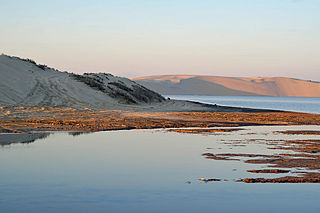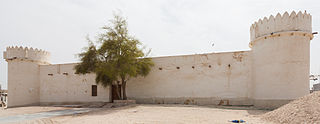Related Research Articles

Zubarah, also referred to as Al Zubarah or Az Zubarah, is a ruined and ancient fort located on the north western coast of the Qatar peninsula in the Al Shamal municipality, about 105 km from the Qatari capital of Doha. It was founded by Shaikh Muhammed bin Khalifa, the founder father of Al Khalifa royal family of Bahrain, the main and principal Utub tribe in the first half of the eighteenth century. It was designated a UNESCO World Heritage Site in 2013.

Al Shamal is a municipality in the state of Qatar. Its seat is called Madinat ash Shamal and it is considered to be one of the major cities in Qatar, although the population is barely over 8,000. The seat's name translates to "city of the north".

Umm Salal Mohammed is a town in the municipality of Umm Salal in Qatar. The town has numerous farms, wells and a large water reservoir which is filled during the rainy season.

Ar-Ruʼays, also spelled Al Ruwais, is a port town in the municipality of Al Shamal in Qatar. It is located on the northern tip of Qatar, approximately 127 km (79 mi) north of the capital Doha. Before the country's economic landscape was transformed from oil extraction, Al Ruwais was one of the most important fishing centers on the peninsula.
Since the early 2000s, Doha, the capital of Qatar has been undergoing an extensive expansion in its transportation network including the addition of new highways, the construction of a new airport, and the under-construction Doha metro. These projects are meant to keep up with the population's rapid growth, which has strained the country's current infrastructure.

Al Khor is a coastal city in northern Qatar, located 50 kilometres north of the capital, Doha. Considered one of Qatar's largest cities, it is the capital city of the municipality of Al Khor. The name of the city means creek in Arabic; it was given this name because the original settlement was built on a creek.

Al Khor, officially Al Khor and Al Thakhira, is a municipality in coastal northeastern Qatar. Al Khor City, the municipal seat, is located in the northeast coast of Qatar, around 50 kilometres from the capital, Doha and it is considered to be one of the major cities in Qatar. Al Thakhira is the second largest settlement in the municipality after Al Khor City.

Protected areas of Qatar include:

Barzan Towers, also known as the Umm Salal Mohammed Fort Towers, are watchtowers that were built in the late 19th century and renovated in 1910 by Sheikh Mohammed bin Jassim Al Thani. They are located at the southern side of the defensive system established at the end of the 19th century and start of the 20th century to protect the 'rawdat', a valley where precious rainwater is collected when it flows down from higher ground. In Arabic "barzan" means "high place".

Al Koot Fort most commonly known as the Doha Fort, is a historical military fortress located in the heart of Doha, Qatar's capital city. It was built in 1927 by Sheikh Abdulla bin Qassim Al Thani, better known as Sheikh Abdullah bin Jassim Al Thani, who ruled Qatar from 1913 until 1949, after Sheikh Mohammed bin Jassim Al Thani, Sheikh Abdullah's brother, abdicated in favor of him. The fort was later converted into a museum.

Al Zubara Fort, also known as Fort Zubara(h), Zubara(h) Fort, Al Zubarah Fort, or Az Zubara(h) Fort, is a historic Qatari military fortress built under the oversight of Sheikh Abdullah bin Jassim Al Thani in 1938.

Archaeology of Qatar as a field study began in 1956. Three major expeditions were carried out in Qatar throughout the mid-20th century, with the first being launched by a Danish team who began work in the 1950s. This was followed by British and French expeditions in 1970s and 1980s, respectively. Approximately 200 archaeological sites were discovered during these expeditions, with the most extensive being the coastal areas of Al Da'asa, Ras Abrouq and Al Khor Island. Artifacts such as flint tools, Ubaid and Barbar pottery and encampments were found in situ.

Al Thakhira is a town on the coast of the Al Khor municipality in Qatar, about 7 kilometres (4.3 mi) northeast of the city of Al Khor City and 60 kilometres (37 mi) from the capital Doha. It is closely affiliated with Al Khor City, with both having been founded by the Al Muhannadi tribe. Like other coastal settlements in the area, its inhabitants historically relied solely on pearling and fishing for sustenance.

Ras Abrouq is the northernmost extension of the Zekreet Peninsula, a stretch of land to the north of Dukhan in Qatar. It has a beach of the same name and various archaeological sites. Since the 21st century it has functioned as a tourist site.

The flora of Qatar includes more than 300 species of wild plants. Qatar occupies a small desert peninsula that is around 80 km from east to west and 160 km from north to south. The climate is hot and humid with sporadic rain. Majority of the country is flat with an annual rainfall average of less than 3 inches. Arnebia hispidissim blooms yellow flowers annually in sandy soil. Glossonema edule has edible fruits with brownish-yellow flowers.

Zekreet is a village in north-western Qatar near Dukhan and about 80 km north-west west of Doha. Originally a sparsely populated area, Zekreet was built up in the 1940s after oil operations commenced in Qatar. This included the construction of a harbor for oil equipment and a number of small houses which eventually developed into a village. There are a number of visitor attractions and old ruins at the site, one of the most notable being Zekreet Fort, which is housed to the immediate north of the village.

The Zekreet Peninsula, also known as the Abrouq Peninsula, is a peninsula in western Qatar, located to the north of the industrial city of Dukhan. Much of the area is associated with erosional landforms such as foothills, mesas and gypsum plateaux. The village of Zekreet, the Zekreet Film City, and the headland of Ras Abrouq are all found on this stretch of land. The peninsula is part of the Al Reem Biosphere Reserve.
References
- ↑ "Tourism in the MENA Region". World Tourism Organization. Retrieved 7 March 2019.
